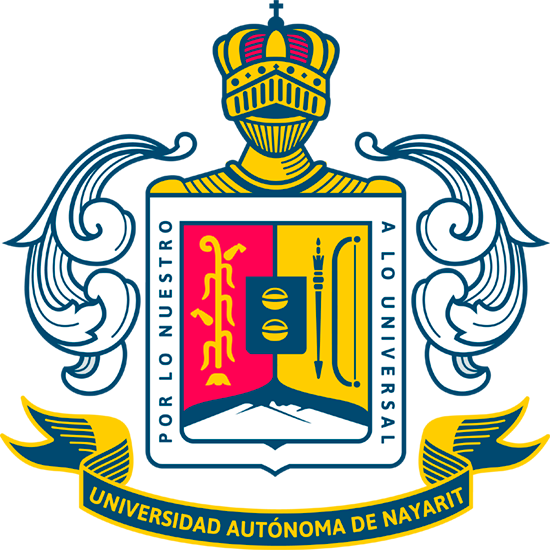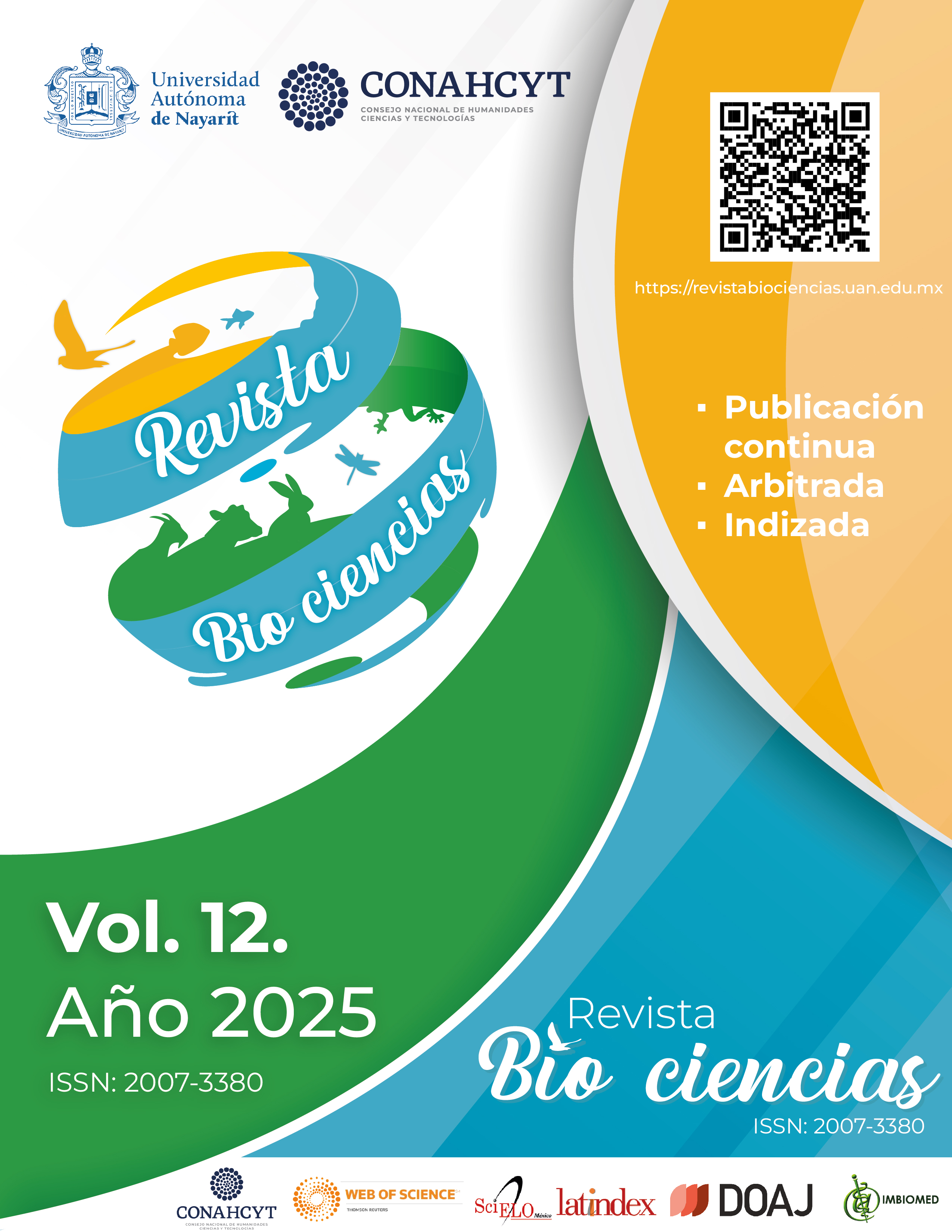Resumen
Este estudio examino el empleo de métodos computacionales (docking molecular), para predecir la actividad biológica de una molécula, mediante el acoplamiento/interacción de esta sobre un sistema biológico (enzima). Como es el caso del compuesto aislado del árbol de Cordia elaeagnoides denominado aliodorin, con el cual se determinó su posible uso como conservante o antifúngico. Esto al realizarse un análisis in silico sobre la enzima lacasa, la cual es la principal enzima segregada por el hongo xilófago Trametes versicolor y la que lleva a cabo los procesos de degradación de los principales componentes de la madera (lignina, celulosa y hemicelulosa), siendo este mecanismo por el cual el hongo obtiene nutrientes para su desarrollo. Por lo tanto, se considera que al inhibir/inactivar a la enzima lacasa se inhibe al hongo T. versicolor, lo cual fue demostrado posteriormente al realizarse las pruebas de inhibición mediante el método de difusión en placa con el aliodorin sobre T. versicolor.
Citas
Archibald, F. S., Bourbonnais, R., Jurasek, L., Paice, M. G., & Reid, I. D. (1997). Kraft pulp bleaching and delignification by Trametes 6ersicolor. In Journal of Biotechnology, 53 (2-3), 215-236. https://doi.org/10.1016/S0168-1656(97)01675-1
American Society for Testing and Materials [ASTM] . (1994). 81, Standard Test Method for Accelerated Laboratory Test of Natural Decay Resistance of Woods, Annual Book of ASTM Standars, Vol. 04.09. Philadelphia: American Society for Testing and Materials-ASTM, 324–328.
Augustine, A. J., Kragh, M. E., Sarangi, R., Fujii, S., Liboiron, B. D., Stoj, C. S., Kosman, D. J., Hodgson, K. O., Hedman, B., & Solomon, E. I. (2008). Spectroscopic studies of perturbed T1 Cu sites in the multicopper oxidases Saccharomyces cerevisiae Fet3p and Rhus vernicifera laccase: Allosteric coupling between the T1 and trinuclear Cu sites. Biochemistry, 47(7), 2036–2045. https://doi.org/10.1021/bi7020052
Bari, E., Nazarnezhad, N., Kazemi, S. M., Tajick Ghanbary, M. A., Mohebby, B., Schmidt, O., & Clausen, C. A. (2015). Comparison between degradation capabilities of the white rot fungi Pleurotus ostreatus and Trametes versicolor in beech wood. International Biodeterioration and Biodegradation, 104, 231–237. https://doi.org/10.1016/j.ibiod.2015.03.033
Chiranjeevi, P. V., Rajasekara, M., & Sathish, T. (2014). Enhancement of Laccase Production from Pleurotus ostreatus PVCRSP-7 by altering the Nutritional Conditions using Response Surface Methodology. In BioResources, 9(3), 4212-4225. htps://doi/10.15376/biores.9.3.4212-4225
de Castro, V. R., de Castro Freitas, M. P., Zanuncio, A. J. V., Zanuncio, J. C., Surdi, P. G., Carneiro, A. de C. O., & Vital, B. R. (2019). Resistance of in natura and torrefied wood chips to xylophage fungi. Scientific Reports, 9(1), 11068. https://doi.org/10.1038/s41598-019-47398-9
El-Hachem, N., Haibe-Kains, B., Khalil, A., Kobeissy, F. H., & Nemer, G. (2017). AutoDock and AutoDockTools for protein-ligand docking: beta-site amyloid precursor protein cleaving enzyme 1 (BACE1) as a case study. Neuroproteomics: Methods and Protocols, 391-403. https://doi.org/10.1007/978-1-4939-6952-4_20
Ferreira, L. G., Dos Santos, R. N., Oliva, G., & Andricopulo, A. D. (2015). Molecular docking and structure-based drug design strategies. In Molecules, 20(7), 13384–13421. https://doi.org/10.3390/molecules200713384
Frisch, M. J., Trucks, G. W., Schlegel, H. B., Scuseria, G. E., Robb, M. A., Cheeseman, J. R., Scalmani, G., Barone, V., Petersson, G. A., & Nakatsuji, H. (2016). Gaussian 16, revision a. 03, gaussian, inc., wallingford ct. Gaussian16 (Revision A. 03).
García, M., L., B., De Pascual-Teresa, M., & Fernández, B. (2004). Estudio teórico del modo de unión entre CDK2 y butirolactona I *. Buy RoboPDF. In An. R Acad. Nac. Farm, 70. Artículo Original. www.robopdf.com
Gochev, V. K., & Krastanov, A. I. (2007). Fungal Laccases (Review). Bulgarian Journal of Agricultural Science, 13, 75-83
Götze, J. P., & Bühl, M. (2016). Laccase Redox Potentials: PH Dependence and Mutants, a QM/MM Study. Journal of Physical Chemistry B, 120(35), 9265–9276. https://doi.org/10.1021/acs.jpcb.6b04978
Guevara-Martínez, S. J., Villanueva-Mejía, F., Zamudio-Ojeda, A., Herrera-Bucio, R., & Morales-Palacios, F. G. (2024). Isolation of the Antifungal Compound Alliodorin from the Heartwood of Cordia elaeagnoides A. DC. and the In Silico Analysis of the Laccase. Plants, 13(10), 1294. https://doi.org/10.3390/plants13101294
Heldin, C.-H., Lu, B., Evans, R., & Gutkind, J. S. (2016). Signals and receptors. Cold Spring Harbor Perspectives in Biology, 8(4), a005900. https://doi.org/10.1101/cshperspect.a005900
Honarparvar, B., Govender, T., Maguire, G. E. M., Soliman, M. E. S., & Kruger, H. G. (2014). Integrated approach to structure-based enzymatic drug design: Molecular modeling, spectroscopy, and experimental bioactivity. In Chemical Reviews, 114(1), 493–537. https://doi.org/10.1021/cr300314q
Janusz, G., Pawlik, A., Świderska-Burek, U., Polak, J., Sulej, J., Jarosz-Wilkołazka, A., & Paszczyński, A. (2020). Laccase properties, physiological functions, and evolution. International journal of molecular sciences, 21(3), 966. https://doi.org/10.3390/ijms21030966
Johannes, C., & Majcherczyk, A. (2000). Laccase activity tests and laccase inhibitors. In Journal of Biotechnology, 78(2), 193-199. https://doi.org/10.1016/S0168-1656(00)00208-X
Macalino, S. J. Y., Basith, S., Clavio, N. A. B., Chang, H., Kang, S., & Choi, S. (2018). Evolution of in silico strategies for protein-protein interaction drug discovery. In Molecules, 23(8), 1963. https://doi.org/10.3390/molecules23081963
Madhavi, V., & Lele, S. S. (2009). Laccase: properties and applications. BioResources, 4(4). https://doi.org/10.15376/biores.4.4.1694-1717
Manners, G. D. (1983). The hydroquinone terpenoids of Cordia elaeagnoides. Journal of the Chemical Society, Perkin Transactions, 1, 39–43.
Martínez-Sotres, C., López-Albarrán, P., Cruz-de-León, J., García-Moreno, T., Rutiaga-Quiñones, J. G., Vázquez-Marrufo, G., Tamariz-Mascarúa, J., & Herrera-Bucio, R. (2012). Medicarpin, an antifungal compound identified in hexane extract of Dalbergia congestiflora Pittier heartwood. International Biodeterioration and Biodegradation, 69, 38–40. https://doi.org/10.1016/j.ibiod.2011.11.016
Martínez-Sotres, C., Rutiaga-Quiñones, J. G., Herrera-Bucio, R., Gallo, M., & López-Albarrán, P. (2015). Molecular docking insights into the inhibition of laccase activity by medicarpin. Wood Science and Technology, 49(4), 857–868.
Mielnichuk, N., & Lopez, S. E. (2007). Interaction between Epicoccum purpurascens and xylophagous basidiomycetes on wood blocks. Forest Pathology, 37(4), 236–242. https://doi.org/10.1111/j.1439-0329.2007.00496.x
Mohan, V., Gibbs, A. C., Cummings, M. D., Jaeger, E. P., & Desjarlais, R. L. (2005). Docking: Successes and Challenges. In Current Pharmaceutical Design, 11. https://doi.org/10.2174/1381612053382106
Morris, G. M., Goodsell, D. S., Halliday, R. S., Huey, R., Hart, W. E., Belew, R. K., & Olson, A. J. (1998). Automated docking using a Lamarckian genetic algorithm and an empirical binding free energy function. Journal of Computational Chemistry, 19(14), 1639–1662. https://doi.org/10.1002/(SICI)1096-987X(19981115)19:14<1639::AID-JCC10>3.0.CO;2-B
Morris, G. M., Ruth, H., Lindstrom, W., Sanner, M. F., Belew, R. K., Goodsell, D. S., & Olson, A. J. (2009). Software news and updates AutoDock4 and AutoDockTools4: Automated docking with selective receptor flexibility. Journal of Computational Chemistry, 30(16), 2785–2791. https://doi.org/10.1002/jcc.21256
Pardo, I., & Camarero, S. (2015). Laccase engineering by rational and evolutionary design. In Cellular and Molecular Life Sciences, 72(5), 897–910. https://doi.org/10.1007/s00018-014-1824-8
Piontek, K., Antorini, M., & Choinowski, T. (2002). Crystal structure of a laccase from the fungus Trametes versicolor at 1.90-Å resolution containing a full complement of coppers. Journal of Biological Chemistry, 277(40), 37663–37669. https://doi.org/10.1074/jbc.M204571200
Reynaldi, M. A., Faradilla, A., Sari, R., Riza, H., & Najini, R. (2024). Comparative Analysis of the Autodock 4.2 and Autodock Vina Methods in Predicting Thiazolidinedione Interactions with PPARG Receptor. Ad-Dawaa'Journal of Pharmaceutical Sciences, 7(1). https://doi.org/10.24252/djps.v7i1.47852
Roy, J. D. (2022). In silico study of bioremediation property of microbial laccase enzymes 3CG8 and 1GYC. Journal of Applied and Fundamental Sciences, 8(1), 13-38.
Rutiaga-Quiñones, J. G. (2001). Chemische und biologische Untersuchungen zum Verhalten dauerhafter Holzarten und ihrer Extrakte gegenüber holzabbauenden Pilzen. Buchverl. Gräfelfing.
Singh, D., & Gupta, N. (2020). Microbial Laccase: a robust enzyme and its industrial applications. Biologia, 75(8), 1183-1193. https://doi.org/10.2478/s11756-019-00414-9
Sun, X. B., Yang, Z. H., Jin, D. J., Qiu, Y. G., & Gu, W. (2023). Design, synthesis and antifungal evaluation of novel nopol derivatives as potent laccase inhibitors. Pest Management Science, 79(7), 2469-2481. https://doi.org/10.1002/ps.7426
Strong, P. J., & Claus, H. (2011). Laccase: A review of its past and its future in bioremediation. In Critical Reviews in Environmental Science and Technology, 41(4), 373–434. https://doi.org/10.1080/10643380902945706
Tišma, M., Žnidaršič-Plazl, P., Šelo, G., Tolj, I., Šperanda, M., Bucić-Kojić, A., & Planinić, M. (2021). Trametes versicolor in lignocellulose-based bioeconomy: State of the art, challenges and opportunities. In Bioresource Technology, 330. https://doi.org/10.1016/j.biortech.2021.124997
Vega-Ceja, J. E., Jiménez-Amezcua, R. M., Anzaldo-Hernández, J., Silva-Guzmán, J. A., Torres-Rendón, J. G., Lomelí-Ramírez, M. G., & García-Enriquez, S. (2022). Antifungal Activity of Datura stramonium L. Extractives against Xylophagous Fungi. Forests, 13(8). https://doi.org/10.3390/f13081222
Velásquez, J., Toro, M. E., Rojas, L., & Encinas, O. (2006). Actividad antifúngica in vitro de los extractivos naturales de especies latifoliadas de la Guayana Venezolana. Madera y Bosques, 12(1), 51–61. https://doi.org/10.21829/myb.2006.1211250
Velásquez, M., Drosos, J., Gueto, C., Márquez, J., & Vivas-Reyes, R. (2013). Método acoplado Autodock-PM6 para seleccionar la mejor pose en estudios de acoplamiento molecular. Revista Colombiana de Quimica, 42(1), 101–124.
Vovchuk, C. S., González Garello, T., Careaga, V. P., & Fazio, A. T. (2024). Promising Antifungal Activity of Cedrela fissilis Wood Extractives as Natural Biocides against Xylophagous Fungi for Wood Artwork of Cultural Heritage. Coatings, 14(2), 237. https://doi.org/10.3390/coatings14020237
Warshel, A. (2014). Multiscale modeling of biological functions: From enzymes to molecular machines (nobel lecture). Angewandte Chemie - International Edition, 53(38), 10020–10031. https://doi.org/10.1002/anie.201403689
Xu, F. (1996). Oxidation of Phenols, Anilines, and Benzenethiols by Fungal Laccases: Correlation between Activity and Redox Potentials as Well as Halide Inhibition. Biochemistry, 35(23), 7608-7614. https://doi.org/10.1021/bi952971a

Revista Bio Ciencias por Universidad Autónoma de Nayarit se encuentra bajo una Licencia Creative Commons Atribución-NoComercial-SinDerivadas 4.0 Unported.
Basada en una obra en http://biociencias.uan.edu.mx/.
Permisos que vayan más allá de lo cubierto por esta licencia pueden encontrarse en http://editorial.uan.edu.mx/index.php/BIOCIENCIAS.licencia de Creative Commons Reconocimiento-NoComercial-SinObraDerivada 4.0 Internacional






